|
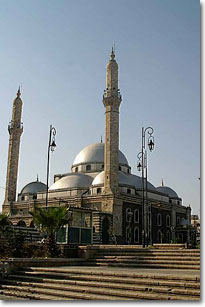 162 km north of Damascus; Homs (ancient Emesa) is strategically placed at the intersection of the natural north/south corridor and the access route from the Syrian Desert to the coast through the break in the coastal mountain chains known as the Homs Gap. Homs site is also determined by the Orontes River which flows through the city. Today it is a key point in the Syrian road and rail networks and the base for several major industries. 162 km north of Damascus; Homs (ancient Emesa) is strategically placed at the intersection of the natural north/south corridor and the access route from the Syrian Desert to the coast through the break in the coastal mountain chains known as the Homs Gap. Homs site is also determined by the Orontes River which flows through the city. Today it is a key point in the Syrian road and rail networks and the base for several major industries.
History:
The city goes back well before Roman times. It was overshadowed in the pre-Roman period by larger centers in the region, including Qatna (Mishrifeh), Arethusa (al Rastan) and Qadesh. After 145 BC, it became the base for the Arab dynasty of the Samsigeramos, one of several pretenders to the crumbling remains of the Greek Kingdom. Control of the desert tribes became crucial to the city's fortunes in the first three centuries of Roman rule. Its destiny marched closely with that of Palmyra with which it enjoyed close ties. As long as Palmyra helped control the security of the central desert and keep the tribes in check, the caravan route based on Homs was viable. Once the desert became unsafe, the caravans by-passed it, preferring the safer reaches of the traditional northern route via the upper Euphrates and Aleppo.
Julia Domna, a daughter of the High Priest of Emesa, married Septimus Severus, the future Emperor (ruled 193 - 211) around AD 187 following a period in which he was stationed in Syria as a commander of the IV Scythia Legion. She was described by Gibbon as deserving "all that the stars could promise her".
Homs became an important center after the Arab conquest, rather more fervent and puritanical in its attachment to Islam than the Umayyad court at Damascus. It later avoided attack by the Crusaders in spite of their string presence at the nearby Krak des Chevaliers. Less prosperous than Hama in the Arab and Ottoman eras, it had fallen into a steep decline by the 18th century. By 1914, it had a population of no more than 5000.
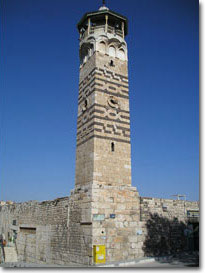 The Great Mosque al Nūri: The Great Mosque al Nūri:
It is a vas rectangular building with an oblong courtyard, oriented east/west, it lies on what was probably the site of the pagan sun temple and the later Church of St John.
Old Churches:
- Church of al Zunnar (the church of the Virgin's belt):
the curious name derives from the discovery under the church's altar in 1953 of a textile belt said to have belonged to the Virgin. The belt is believed to have been placed in the first church on this spot in the late forth century. Most of the present church's structure dates from the last 100 years.
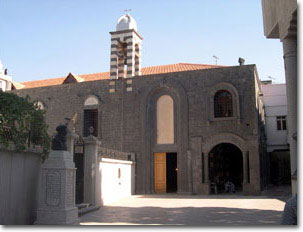 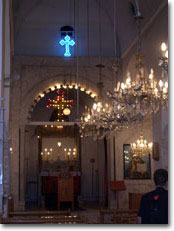
- Church of St Elian:
it is more interesting the frescoes found in this church. Church of St Elian is dedicated to the son of a Roman officer from Emesa martyred at the end of the third century for refusing to renounce Christianity. The martyrium at the end of right hand nave is the burial place of St Elian and other saints and houses a remarkable set of mural paintings of the 12th century and earlier which were discovered in 1970. The church is still a pilgrimage center due to the miracles associated with St Elian and its renewed fame has resulted in an expansion and redecoration of the main nave. The modern painted frescoes are devoted to the life of St Elian.
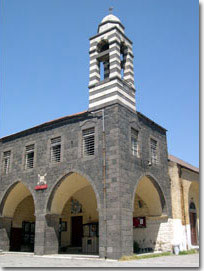 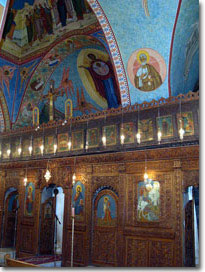 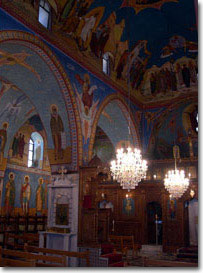
Walls:
The walls of the city and its seven gates were largely demolished in the ottoman period. Remains of two of the gates survive in Bab al Masdud (Closed Gate) in the west and Bab Tadmor (Palmyra Gate) to the north east. Only a few glimpses of the old walls survive. The remains of the citadel of Homs can be seen on the mound which marks the south west corner of the old city.
Mosque of Khaled Ibn al Walid:
The mosque, completely rebuilt in the late Turkish period (1908 - 13), is on a site dating back to Ayyūbid times and contains the reputed tomb of one of the early followers of Muhammed, Khaled Ibn al Walid, whose military campaigns in Syria led to the Islamic conquest. He died in 642; his exploits have been eclipsed by his sworn enemy, the Caliph Umar.
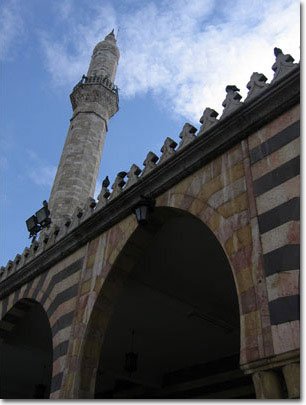 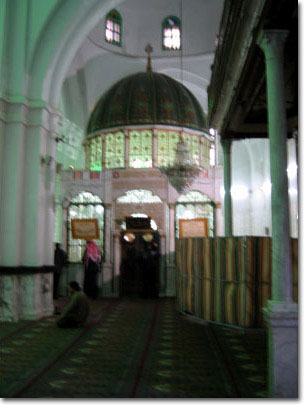
|


